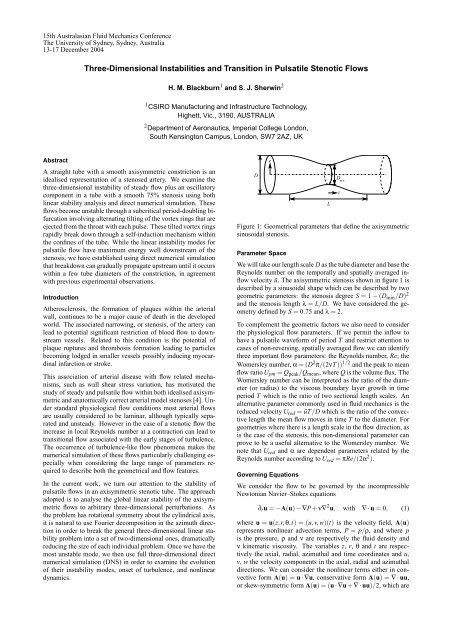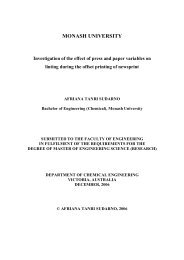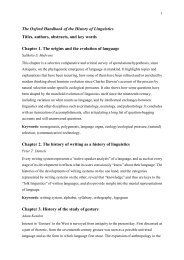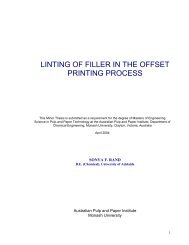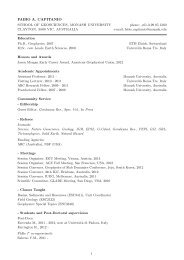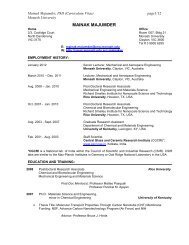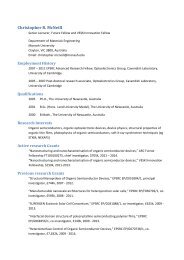Three-Dimensional Instabilities and Transition in Pulsatile Stenotic ...
Three-Dimensional Instabilities and Transition in Pulsatile Stenotic ...
Three-Dimensional Instabilities and Transition in Pulsatile Stenotic ...
Create successful ePaper yourself
Turn your PDF publications into a flip-book with our unique Google optimized e-Paper software.
15th Australasian Fluid Mechanics Conference<br />
The University of Sydney, Sydney, Australia<br />
13-17 December 2004<br />
Abstract<br />
<strong>Three</strong>-<strong>Dimensional</strong> <strong>Instabilities</strong> <strong>and</strong> <strong>Transition</strong> <strong>in</strong> <strong>Pulsatile</strong> <strong>Stenotic</strong> Flows<br />
A straight tube with a smooth axisymmetric constriction is an<br />
idealised representation of a stenosed artery. We exam<strong>in</strong>e the<br />
three-dimensional <strong>in</strong>stability of steady flow plus an oscillatory<br />
component <strong>in</strong> a tube with a smooth 75% stenosis us<strong>in</strong>g both<br />
l<strong>in</strong>ear stability analysis <strong>and</strong> direct numerical simulation. These<br />
flows become unstable through a subcritical period-doubl<strong>in</strong>g bifurcation<br />
<strong>in</strong>volv<strong>in</strong>g alternat<strong>in</strong>g tilt<strong>in</strong>g of the vortex r<strong>in</strong>gs that are<br />
ejected from the throat with each pulse. These tilted vortex r<strong>in</strong>gs<br />
rapidly break down through a self-<strong>in</strong>duction mechanism with<strong>in</strong><br />
the conf<strong>in</strong>es of the tube. While the l<strong>in</strong>ear <strong>in</strong>stability modes for<br />
pulsatile flow have maximum energy well downstream of the<br />
stenosis, we have established us<strong>in</strong>g direct numerical simulation<br />
that breakdown can gradually propagate upstream until it occurs<br />
with<strong>in</strong> a few tube diameters of the constriction, <strong>in</strong> agreement<br />
with previous experimental observations.<br />
Introduction<br />
Atherosclerosis, the formation of plaques with<strong>in</strong> the arterial<br />
wall, cont<strong>in</strong>ues to be a major cause of death <strong>in</strong> the developed<br />
world. The associated narrow<strong>in</strong>g, or stenosis, of the artery can<br />
lead to potential significant restriction of blood flow to downstream<br />
vessels. Related to this condition is the potential of<br />
plaque ruptures <strong>and</strong> thrombosis formation lead<strong>in</strong>g to particles<br />
becom<strong>in</strong>g lodged <strong>in</strong> smaller vessels possibly <strong>in</strong>duc<strong>in</strong>g myocard<strong>in</strong>al<br />
<strong>in</strong>farction or stroke.<br />
This association of arterial disease with flow related mechanisms,<br />
such as wall shear stress variation, has motivated the<br />
study of steady <strong>and</strong> pulsatile flow with<strong>in</strong> both idealised axisymmetric<br />
<strong>and</strong> anatomically correct arterial model stenoses [4]. Under<br />
st<strong>and</strong>ard physiological flow conditions most arterial flows<br />
are usually considered to be lam<strong>in</strong>ar, although typically separated<br />
<strong>and</strong> unsteady. However <strong>in</strong> the case of a stenotic flow the<br />
<strong>in</strong>crease <strong>in</strong> local Reynolds number at a contraction can lead to<br />
transitional flow associated with the early stages of turbulence.<br />
The occurrence of turbulence-like flow phenomena makes the<br />
numerical simulation of these flows particularly challeng<strong>in</strong>g especially<br />
when consider<strong>in</strong>g the large range of parameters required<br />
to describe both the geometrical <strong>and</strong> flow features.<br />
In the current work, we turn our attention to the stability of<br />
pulsatile flows <strong>in</strong> an axisymmetric stenotic tube. The approach<br />
adopted is to analyse the global l<strong>in</strong>ear stability of the axisymmetric<br />
flows to arbitrary three-dimensional perturbations. As<br />
the problem has rotational symmetry about the cyl<strong>in</strong>drical axis,<br />
it is natural to use Fourier decomposition <strong>in</strong> the azimuth direction<br />
<strong>in</strong> order to break the general three-dimensional l<strong>in</strong>ear stability<br />
problem <strong>in</strong>to a set of two-dimensional ones, dramatically<br />
reduc<strong>in</strong>g the size of each <strong>in</strong>dividual problem. Once we have the<br />
most unstable mode, we then use full three-dimensional direct<br />
numerical simulation (DNS) <strong>in</strong> order to exam<strong>in</strong>e the evolution<br />
of their <strong>in</strong>stability modes, onset of turbulence, <strong>and</strong> nonl<strong>in</strong>ear<br />
dynamics.<br />
H. M. Blackburn 1 <strong>and</strong> S. J. Sherw<strong>in</strong> 2<br />
1 CSIRO Manufactur<strong>in</strong>g <strong>and</strong> Infrastructure Technology,<br />
Highett, Vic., 3190, AUSTRALIA<br />
2 Department of Aeronautics, Imperial College London,<br />
South Kens<strong>in</strong>gton Campus, London, SW7 2AZ, UK<br />
D<br />
r<br />
Figure 1: Geometrical parameters that def<strong>in</strong>e the axisymmetric<br />
s<strong>in</strong>usoidal stenosis.<br />
Parameter Space<br />
We will take our length scale D as the tube diameter <strong>and</strong> base the<br />
Reynolds number on the temporally <strong>and</strong> spatially averaged <strong>in</strong>flow<br />
velocity ū. The axisymmetric stenosis shown <strong>in</strong> figure 1 is<br />
described by a s<strong>in</strong>usoidal shape which can be described by two<br />
geometric parameters: the stenosis degree S = 1 −(Dm<strong>in</strong>/D) 2<br />
<strong>and</strong> the stenosis length λ = L/D. We have considered the geometry<br />
def<strong>in</strong>ed by S = 0.75 <strong>and</strong> λ = 2.<br />
To complement the geometric factors we also need to consider<br />
the physiological flow parameters. If we permit the <strong>in</strong>flow to<br />
have a pulsatile waveform of period T <strong>and</strong> restrict attention to<br />
cases of non-revers<strong>in</strong>g, spatially averaged flow we can identify<br />
three important flow parameters: the Reynolds number, Re; the<br />
Womersley number, α = (D 2 π/(2νT)) 1/2 <strong>and</strong> the peak to mean<br />
flow ratio Upm = Qpeak/Qmean, where Q is the volume flux. The<br />
Womersley number can be <strong>in</strong>terpreted as the ratio of the diameter<br />
(or radius) to the viscous boundary layer growth <strong>in</strong> time<br />
period T which is the ratio of two sectional length scales. An<br />
alternative parameter commonly used <strong>in</strong> fluid mechanics is the<br />
reduced velocity Ured = ūT/D which is the ratio of the convective<br />
length the mean flow moves <strong>in</strong> time T to the diameter. For<br />
geometries where there is a length scale <strong>in</strong> the flow direction, as<br />
is the case of the stenosis, this non-dimensional parameter can<br />
prove to be a useful alternative to the Womersley number. We<br />
note that Ured <strong>and</strong> α are dependent parameters related by the<br />
Reynolds number accord<strong>in</strong>g to Ured = πRe/(2α 2 ).<br />
Govern<strong>in</strong>g Equations<br />
We consider the flow to be governed by the <strong>in</strong>compressible<br />
Newtonian Navier–Stokes equations<br />
L<br />
D m<strong>in</strong><br />
∂tu = −A(u) − ∇P+ν∇ 2 u, with ∇ · u = 0, (1)<br />
where u = u(z,r,θ,t) = (u,v,w)(t) is the velocity field, A(u)<br />
represents nonl<strong>in</strong>ear advection terms, P = p/ρ, <strong>and</strong> where p<br />
is the pressure, ρ <strong>and</strong> ν are respectively the fluid density <strong>and</strong><br />
ν k<strong>in</strong>ematic viscosity. The variables z, r, θ <strong>and</strong> t are respectively<br />
the axial, radial, azimuthal <strong>and</strong> time coord<strong>in</strong>ates <strong>and</strong> u,<br />
v, w the velocity components <strong>in</strong> the axial, radial <strong>and</strong> azimuthal<br />
directions. We can consider the nonl<strong>in</strong>ear terms either <strong>in</strong> convective<br />
form A(u) = u · ∇u, conservative form A(u) = ∇ · uu,<br />
or skew-symmetric form A(u) = (u · ∇u+∇·uu)/2, which are<br />
z
Figure 2: Spectral element outl<strong>in</strong>es of computational mesh, dimensions given <strong>in</strong> terms of tube diameter D. Panel (a) shows elements<br />
for the first mesh with an outflow at 45D. Panel (b) shows a close-up of the throat, with curved element edges.<br />
all equivalent <strong>in</strong> a cont<strong>in</strong>uum sett<strong>in</strong>g. Equation (1) is subject to<br />
no-slip boundary conditions at the walls, a prescribed velocity<br />
at the <strong>in</strong>flow (steady or periodic), conditions of zero pressure<br />
<strong>and</strong> zero outward normal derivatives of velocity at the outflow<br />
<strong>and</strong> consistent regularity boundary conditions at the axis as expla<strong>in</strong>ed<br />
<strong>in</strong> [7].<br />
Tak<strong>in</strong>g the pressure to represent the solution of a Poisson equation<br />
that has the divergence of the advection terms as forc<strong>in</strong>g,<br />
we can consider the Navier–Stokes equations <strong>in</strong> symbolic form<br />
as<br />
∂tu = −(I − ∇∇ −2 ∇·)A(u)+ν∇ 2 u = N(u)+L(u) (2)<br />
where the nonl<strong>in</strong>ear operator N conta<strong>in</strong>s contributions from<br />
both pressure <strong>and</strong> advection terms, while the l<strong>in</strong>ear operator L<br />
corresponds to viscous diffusion.<br />
When analys<strong>in</strong>g the l<strong>in</strong>ear stability of a flow <strong>in</strong> terms of its normal<br />
modes, we decompose the velocity u <strong>in</strong>to a base flow U <strong>and</strong><br />
perturbation flow u ′ : u = U+u ′ , <strong>and</strong> exam<strong>in</strong>e the stability of<br />
the perturbation l<strong>in</strong>earised about the base flow. In this decomposition,<br />
the orig<strong>in</strong>al nonl<strong>in</strong>ear advection terms are replaced<br />
with their l<strong>in</strong>earised equivalent (here for the convective form)<br />
∂UA(u ′ ) = U · ∇u ′ + u ′ ·∇U <strong>and</strong> <strong>in</strong> symbolic form we write<br />
∂tu ′ = ∂UN(u ′ )+L(u ′ ) (3)<br />
for the evolution of the l<strong>in</strong>ear perturbation. If the base flow is<br />
T -periodic <strong>in</strong> time, ∂UN is l<strong>in</strong>ear time-periodic, <strong>and</strong><br />
u ′ Z <br />
t0+T<br />
(t0 + T) = exp (∂UN+L)dt u ′ (t0). (4)<br />
t0<br />
The eigenpairs of this Floquet problem are {µ, ũ(t0)} where<br />
µ is a Floquet multiplier <strong>and</strong> ũ(t0) is the T -periodic Floquet<br />
eigenfunction, evaluated at phase t0. The equivalent to the<br />
eigenvalues γ of the time-<strong>in</strong>variant case are the Floquet exponents<br />
σ, related to the multipliers by µ = expσT . In general,<br />
the Floquet multipliers/exponents <strong>and</strong> eigenfunctions occur <strong>in</strong><br />
complex-conjugate pairs.<br />
S<strong>in</strong>ce the geometry is axisymmetric, the velocity must be 2πperiodic<br />
<strong>in</strong> θ <strong>and</strong> can be projected exactly onto a set of two-dimensional<br />
complex Fourier modes by<br />
ûk(z,r,t) = 1<br />
2π<br />
Z 2π<br />
0<br />
u(z,r,θ,t)exp(−ikθ)dθ (5)<br />
where k is an <strong>in</strong>teger wavenumber. The Fourier-transformed<br />
equations of motion <strong>and</strong> axial boundary conditions for the velocity<br />
<strong>and</strong> pressure (<strong>and</strong> their perturbations) <strong>in</strong> cyl<strong>in</strong>drical coord<strong>in</strong>ates<br />
are described <strong>in</strong> detail <strong>in</strong> [5, 7]. Our base flows are<br />
(b)<br />
(a)<br />
both axisymmetric/two-dimensional, i.e. Uk = 0, k = 0, <strong>and</strong><br />
two-component, i.e. U ≡ (U,V,0). In the numerical stability<br />
analysis we take advantage of l<strong>in</strong>earity, which decouples the<br />
stability problem for each û ′ k .<br />
Numerical Methods<br />
For time evolution of both the full <strong>and</strong> l<strong>in</strong>earised Navier–<br />
Stokes equations, we relied on st<strong>and</strong>ard (nodal-Gauss–Lobatto–<br />
Legendre) spectral elements <strong>in</strong> (z, r) <strong>and</strong> Fourier expansions if<br />
required <strong>in</strong> the azimuthal θ-direction. This spatial discretisation<br />
was coupled with a second-order-time velocity correction time<strong>in</strong>tegration<br />
scheme. The development of this numerical method<br />
for DNS has been described <strong>in</strong> detail <strong>in</strong> [7]. The application<br />
of the method to l<strong>in</strong>earised Navier–Stokes evolution, <strong>in</strong>clud<strong>in</strong>g<br />
appropriate boundary conditions, has also previously been described<br />
<strong>in</strong> [5].<br />
The computational mesh used <strong>in</strong> the calculations is shown <strong>in</strong><br />
figure 2. The doma<strong>in</strong> consists of 743 elemental regions. In each<br />
element, two-dimensional mapped tensor-product Lagrange<strong>in</strong>terpolant<br />
shape functions based on the Gauss–Lobatto–<br />
Legendre nodes were applied. At P = 7 this elemental discretisation<br />
corresponds to approximately 38 000 local degrees<br />
of freedom <strong>in</strong> each meridional semiplane. The doma<strong>in</strong> extended<br />
5D upstream <strong>and</strong> 45D downstream of the throat. As shown <strong>in</strong><br />
figure 2 (b) a f<strong>in</strong>e radial mesh spac<strong>in</strong>g was adopted <strong>in</strong> the region<br />
of the stenosis where two layers each of 5% of the local radius<br />
were applied. At z/D ≈ 7 the radial mesh spac<strong>in</strong>g was coarsened<br />
to allow a uniform axial spac<strong>in</strong>g of 0.5D to be applied to<br />
the outflow. The mesh was ref<strong>in</strong>ed until both the axisymmetric<br />
base flows <strong>and</strong> Floquet multipliers converged to four significant<br />
figures. Typically this also gives enough mesh ref<strong>in</strong>ement <strong>in</strong> the<br />
meridional semi-plane for non-axisymmetric DNS as well, with<br />
the number of planes of data <strong>in</strong> azimuth selected to provide a<br />
three-order or better reduction <strong>in</strong> k<strong>in</strong>etic energy from azimuthal<br />
mode 1 to the highest mode.<br />
The numerical methods employed for stability analysis of both<br />
steady <strong>and</strong> pulsatile flow follow those outl<strong>in</strong>ed <strong>in</strong> [10], <strong>and</strong> previously<br />
described <strong>and</strong> used <strong>in</strong> other works [3, 5, 6]. The analysis<br />
is based on a Krylov-subspace iteration of successive f<strong>in</strong>ite<br />
<strong>in</strong>crements of (<strong>in</strong>itially r<strong>and</strong>om) perturbations through the operator<br />
of (4) us<strong>in</strong>g an Arnoldi method to extract the dom<strong>in</strong>ant<br />
eigenpairs of the exponential operators <strong>in</strong> the equations. The<br />
data used to supply the T -periodic base flow are approximated<br />
through Fourier-series reconstruction from a limited number<br />
(typically 256) of time-slices obta<strong>in</strong>ed from two-dimensional<br />
DNS.
(a)<br />
(b)<br />
(c)<br />
(d)<br />
0 5 10 15<br />
0 5 10 15<br />
z/D<br />
15 20 25 30<br />
15 20 25 30<br />
z/D<br />
Figure 3: The base flow <strong>and</strong> the lead<strong>in</strong>g eigenmode for one phase <strong>in</strong> the flow cycle for the unstable pulsatile flow at Re = 400, Ured = 2.5,<br />
on a vertical centreplane. Panels (a, c) show contours of axial velocity of the base flow, while (b, d) show contours of axial velocity of<br />
the eigenmode.<br />
Figure 4: Growth to saturation of the pulsatile <strong>in</strong>let flow solution<br />
at Ured = 2.5, Re = 400, approximately 3% above Rec, represented<br />
by k<strong>in</strong>etic energies <strong>in</strong> azimuthal Fourier modes, with<br />
Nk = 16. An <strong>in</strong>itial exponential growth phase (<strong>in</strong>dicated by the<br />
dotted l<strong>in</strong>e) is followed by faster than exponential growth near<br />
t/T ∼ 35, an <strong>in</strong>itial nonl<strong>in</strong>ear saturation at t/T ≈ 40, then a f<strong>in</strong>al<br />
slow growth to an asymptotic state, reached at t/T ∼ 250.<br />
Results<br />
Floquet analysis was carried out at Upm = 1.75 <strong>and</strong> for three<br />
values of reduced velocity: Ured = 2.5, 5, <strong>and</strong> 7.5, i.e. successively<br />
longer dimensionless base flow periods. The correspond<strong>in</strong>g<br />
critical Reynolds numbers were found to be Rec = 389,<br />
417 <strong>and</strong> 500. In all three cases, the <strong>in</strong>stability arose through<br />
a period-doubl<strong>in</strong>g bifurcation <strong>in</strong> the k = 1 azimuthal Fourier<br />
mode. The shape <strong>and</strong> location of the Floquet <strong>in</strong>stability mode<br />
for Ured = 2.5, Re = 400 is shown <strong>in</strong> figure 3, where it is compared<br />
to the base flow at the same <strong>in</strong>stant <strong>in</strong> time. The alternat<strong>in</strong>g<br />
sign of the Floquet mode grow<strong>in</strong>g on successive base flow<br />
pulses for a streamwise traverse at any fixed radius is related to<br />
the period-doubl<strong>in</strong>g nature of the <strong>in</strong>stability. The perturbation<br />
exerts alternat<strong>in</strong>g tilt<strong>in</strong>g moments on the vortex r<strong>in</strong>gs associated<br />
with each pulse of the base flow.<br />
Follow<strong>in</strong>g the stability analysis, full three-dimensional DNS of<br />
the <strong>in</strong>stability at Ured = 2.5, Re = 400 was <strong>in</strong>itiated by perturb<strong>in</strong>g<br />
the base flow with a small amount of the lead<strong>in</strong>g Flo-<br />
quet eigenmode <strong>and</strong> evolv<strong>in</strong>g <strong>in</strong> time. The time-evolution of<br />
energies <strong>in</strong> the azimuthal modes is shown <strong>in</strong> figure 4. After a<br />
brief equilibration, there is an exponential growth phase <strong>in</strong> the<br />
non-axisymmetric components, last<strong>in</strong>g until t/T ≈ 35, follow<strong>in</strong>g<br />
which the perturbation grows faster than exponentially with<br />
time before an <strong>in</strong>itial saturation at t/T ≈ 40, signall<strong>in</strong>g that the<br />
bifurcation is subcritical. Then there is an extended slow change<br />
until an asymptotic state is approached at t/T ∼ 250.<br />
The evolution of the flow through time is illustrated by the <strong>in</strong>stantaneous<br />
isosurfaces shown <strong>in</strong> figure 5. The first set of panels,<br />
<strong>in</strong> figure 5 (a), shows the flow state after the <strong>in</strong>itial saturation<br />
at t/T = 40. In the side view, the tilt<strong>in</strong>g of the third vortex<br />
r<strong>in</strong>g <strong>in</strong> the view can be seen, while the fourth <strong>and</strong> fifth r<strong>in</strong>gs <strong>in</strong><br />
the view are further advanced <strong>in</strong> their breakdowns to a packet of<br />
Λ-vortices. In figure 5 (b) we see two <strong>in</strong>stances <strong>in</strong> time lead<strong>in</strong>g<br />
to the asymptotic state: the slow f<strong>in</strong>al growth seen <strong>in</strong> figure 4 is<br />
associated with an upstream movement of the vortex r<strong>in</strong>g breakdown.<br />
At t/T = 280, the flow still has the symmetry of the Floquet<br />
mode, but at that po<strong>in</strong>t a small r<strong>and</strong>om symmetry-break<strong>in</strong>g<br />
perturbation was added to the first azimuthal mode, <strong>and</strong> the flow<br />
further evolved <strong>in</strong> time, lead<strong>in</strong>g to another asymptotic, but now<br />
asymmetric state seen <strong>in</strong> figure 5 (c). At large length <strong>and</strong> time<br />
scales, the flow still has a period-doubl<strong>in</strong>g nature, <strong>in</strong>dicat<strong>in</strong>g<br />
that this is a robust feature.<br />
Discussion<br />
The experimental results of [1, 2, 9] provide a basis for comparison<br />
to our DNS results. These were performed at a higher value<br />
of Ured, but similar Reynolds number (Re ≈ 600) <strong>and</strong> peak-tomean<br />
flow ratio (Upm ≈ 1.7).<br />
In [2] it is stated that ‘turbulence was found only for the 75%<br />
stenosis <strong>and</strong> was created only dur<strong>in</strong>g part of the cycle’, whereas<br />
<strong>in</strong> [1] these fluctuations, which are strongest for 2.5 < z/D 6,<br />
are characterised as non-turbulent ow<strong>in</strong>g to the presence <strong>in</strong> the<br />
conditional velocity spectra of a b<strong>and</strong> of dom<strong>in</strong>ant frequencies<br />
associated with ‘vortex shedd<strong>in</strong>g <strong>and</strong> a turbulent front’. These<br />
f<strong>in</strong>d<strong>in</strong>gs are <strong>in</strong> quite good agreement with the dye-front flow<br />
visualisation <strong>and</strong> <strong>in</strong>terpretation provided by [9]. For the 75%<br />
stenosis, they found four post-stenotic zones: Zone I, reach<strong>in</strong>g<br />
to z/D = 3, is called the ‘stable jet region’, although some <strong>in</strong>dication<br />
of (apparently axisymmetric) wavy structure can be ob-
top<br />
t = 40T<br />
side<br />
t = 132T<br />
t = 280T<br />
t = 300.625T<br />
(a)<br />
(b)<br />
(c)<br />
Figure 5: Visualisations for the DNS of pulsatile flow at Ured = 2.5, Re = 400. Isosurfaces are extracted us<strong>in</strong>g the λ2 criterion [8]. (a)<br />
top <strong>and</strong> side views of the flow just after the <strong>in</strong>itial saturation seen at t/T = 40 <strong>in</strong> figure 4. (b) Two visualisations at later times <strong>in</strong> the<br />
progression to the asymptotic state. Note the upstream movement of breakdown. (c) A detail perspective view of the breakdown of<br />
vortex r<strong>in</strong>gs <strong>in</strong> the cycle follow<strong>in</strong>g t = 300T . Downstream of the stenosis, the first group of structures shows a r<strong>in</strong>g deform<strong>in</strong>g dur<strong>in</strong>g<br />
the f<strong>in</strong>al stages of the tilt<strong>in</strong>g process, while the second group shows the decay<strong>in</strong>g breakdown of the previous r<strong>in</strong>g.<br />
served on the jet front <strong>in</strong> this region; Zone II, 3 < z/D 4.5 is<br />
called the ‘transition region’, where the waves become larger;<br />
<strong>in</strong> Zone III, the ‘turbulent region’, 4.5 < z/D 7.5, the front<br />
rapidly distorts; Zone IV, z/D > 7.5 is labelled ‘relam<strong>in</strong>arization’.<br />
These experimental results are thus <strong>in</strong> reasonable agreement<br />
with the k<strong>in</strong>d of asymptotic behaviour we have observed <strong>in</strong><br />
DNS, as can be seen <strong>in</strong> figure 5 (b, c): a rapid distortion of a vortex<br />
r<strong>in</strong>g becom<strong>in</strong>g evident a few diameters downstream of the<br />
stenosis, lead<strong>in</strong>g to a highly unsteady/transitional breakdown at<br />
z/D ∼ 6, follow<strong>in</strong>g which relam<strong>in</strong>arisation takes place further<br />
downstream.<br />
Conclusions<br />
Floquet analysis of three axisymmetric pulsatile flows shows<br />
that they become three-dimensionally unstable through perioddoubl<strong>in</strong>g<br />
bifurcations <strong>in</strong>volv<strong>in</strong>g alternat<strong>in</strong>g tilt<strong>in</strong>g of the vortex<br />
r<strong>in</strong>gs that are ejected from the stenosis dur<strong>in</strong>g each pulse cycle.<br />
Direct numerical simulation shows that the <strong>in</strong>stability evolves<br />
to vortex r<strong>in</strong>g breakdown, which moves progressively upstream<br />
until it occurs a comparatively few tube diameters downstream<br />
of the stenosis. As the bifurcations are subcritical, hysteretic<br />
effects can be expected with respect to changes <strong>in</strong> Reynolds<br />
number, reduced velocity, or peak-to-mean pulsatility near the<br />
onset of three-dimensionality. The breakdowns are energetic<br />
turbulent events, <strong>and</strong> will lead to regions of high temporal <strong>and</strong><br />
spatial gradients of wall shear stress where they occur. For the<br />
Reynolds numbers studied here, the flow relam<strong>in</strong>arises further<br />
downstream, <strong>and</strong> will eventually recover the conditions of the<br />
pulsatile <strong>in</strong>flow. These f<strong>in</strong>d<strong>in</strong>gs are <strong>in</strong> good agreement with<br />
available experimental results.<br />
Acknowledgements<br />
This work was supported by the Australian Partnership for Advanced<br />
Comput<strong>in</strong>g, the Royal Academy of Eng<strong>in</strong>eer<strong>in</strong>g, <strong>and</strong> the<br />
UK Eng<strong>in</strong>eer<strong>in</strong>g <strong>and</strong> Physical Sciences Research Council.<br />
References<br />
[1] Ahmed SA. An experimental <strong>in</strong>vestigation of pulsatile<br />
flow through a smooth constriction. Exptl Thermal &<br />
Fluid Sci, 17: 309–318, 1998<br />
[2] Ahmed SA & Giddens DP. <strong>Pulsatile</strong> poststenotic flow<br />
studies with laser Doppler anemometry. J Biomechanics,<br />
17(9): 695–705, 1984<br />
[3] Barkley D & Henderson RD. <strong>Three</strong>-dimensional Floquet<br />
stability analysis of the wake of a circular cyl<strong>in</strong>der. J Fluid<br />
Mech, 322: 215–241, 1996<br />
[4] Berger SA & Jou LD. Flows <strong>in</strong> stenotic vessels. Annu Rev<br />
Fluid Mech, 32: 347–384, 2000<br />
[5] Blackburn HM. <strong>Three</strong>-dimensional <strong>in</strong>stability <strong>and</strong> state<br />
selection <strong>in</strong> an oscillatory axisymmetric swirl<strong>in</strong>g flow.<br />
Phys Fluids, 14(11): 3983–3996, 2002<br />
[6] Blackburn HM & Lopez JM. The onset of threedimensional<br />
st<strong>and</strong><strong>in</strong>g <strong>and</strong> modulated travell<strong>in</strong>g waves <strong>in</strong><br />
a periodically driven cavity flow. J Fluid Mech, 497: 289–<br />
317, 2003<br />
[7] Blackburn HM & Sherw<strong>in</strong> SJ. Formulation of a Galerk<strong>in</strong><br />
spectral element–Fourier method for three-dimensional<br />
<strong>in</strong>compressible flows <strong>in</strong> cyl<strong>in</strong>drical geometries. J Comput<br />
Phys, 197(2): 759–778, 2004<br />
[8] Jeong J & Hussa<strong>in</strong> F. On the identification of a vortex.<br />
J Fluid Mech, 285: 69–94, 1995<br />
[9] Ojha M, Cobbold RSC, Johnston KW & Hummel RL.<br />
<strong>Pulsatile</strong> flow through constricted tubes: An experimental<br />
<strong>in</strong>vestigation us<strong>in</strong>g photochromic tracer methods. J Fluid<br />
Mech, 203: 173–197, 1989<br />
[10] Tuckerman LS & Barkley D. Bifurcation analysis for<br />
timesteppers. In E Doedel & LS Tuckerman, editors,<br />
Numerical Methods for Bifurcation Problems <strong>and</strong> Large-<br />
Scale Dynamical Systems, 453–566. Spr<strong>in</strong>ger, 2000


